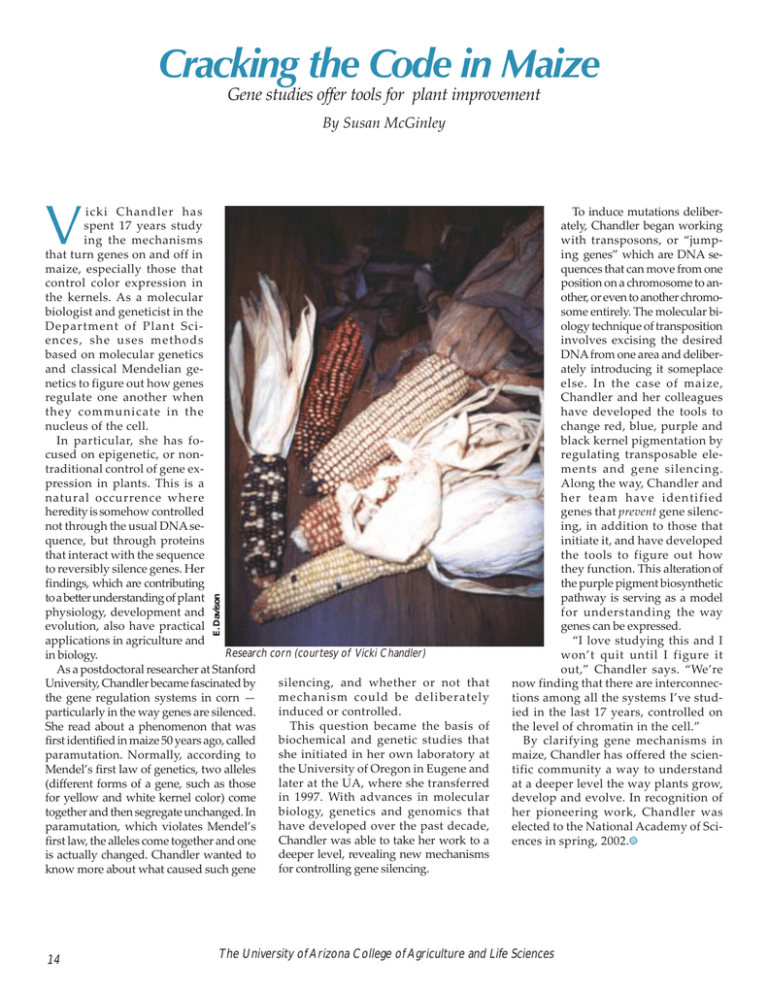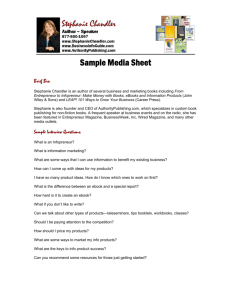V Cracking the Code in Maize By Susan McGinley
advertisement

Cracking the Code in Maize Gene studies offer tools for plant improvement By Susan McGinley V E. Davison icki Chandler has spent 17 years study ing the mechanisms that turn genes on and off in maize, especially those that control color expression in the kernels. As a molecular biologist and geneticist in the Department of Plant Sciences, she uses methods based on molecular genetics and classical Mendelian genetics to figure out how genes regulate one another when they communicate in the nucleus of the cell. In particular, she has focused on epigenetic, or nontraditional control of gene expression in plants. This is a natural occurrence where heredity is somehow controlled not through the usual DNA sequence, but through proteins that interact with the sequence to reversibly silence genes. Her findings, which are contributing to a better understanding of plant physiology, development and evolution, also have practical applications in agriculture and Research corn (courtesy of Vicki Chandler) in biology. As a postdoctoral researcher at Stanford silencing, and whether or not that University, Chandler became fascinated by mechanism could be deliberately the gene regulation systems in corn — induced or controlled. particularly in the way genes are silenced. This question became the basis of She read about a phenomenon that was biochemical and genetic studies that first identified in maize 50 years ago, called she initiated in her own laboratory at paramutation. Normally, according to the University of Oregon in Eugene and Mendel’s first law of genetics, two alleles later at the UA, where she transferred (different forms of a gene, such as those in 1997. With advances in molecular for yellow and white kernel color) come biology, genetics and genomics that together and then segregate unchanged. In have developed over the past decade, paramutation, which violates Mendel’s Chandler was able to take her work to a first law, the alleles come together and one deeper level, revealing new mechanisms is actually changed. Chandler wanted to for controlling gene silencing. know more about what caused such gene 14 To induce mutations deliberately, Chandler began working with transposons, or “jumping genes” which are DNA sequences that can move from one position on a chromosome to another, or even to another chromosome entirely. The molecular biology technique of transposition involves excising the desired DNA from one area and deliberately introducing it someplace else. In the case of maize, Chandler and her colleagues have developed the tools to change red, blue, purple and black kernel pigmentation by regulating transposable elements and gene silencing. Along the way, Chandler and her team have identified genes that prevent gene silencing, in addition to those that initiate it, and have developed the tools to figure out how they function. This alteration of the purple pigment biosynthetic pathway is serving as a model for understanding the way genes can be expressed. “I love studying this and I won’t quit until I figure it out,” Chandler says. “We’re now finding that there are interconnections among all the systems I’ve studied in the last 17 years, controlled on the level of chromatin in the cell.” By clarifying gene mechanisms in maize, Chandler has offered the scientific community a way to understand at a deeper level the way plants grow, develop and evolve. In recognition of her pioneering work, Chandler was elected to the National Academy of Sciences in spring, 2002. The University of Arizona College of Agriculture and Life Sciences L. Butler Vicki Chandler Elected to the National Academy of Sciences Vicki Chandler, a University of Arizona molecular biologist and geneticist known for her pioneering work in clarifying the mechanisms of gene regulation in maize, was elected to the National Academy of Sciences on April 30, 2002. Her findings are contributing to deeper understanding of the way plants grow, develop and evolve. Chandler is a professor in the UA Department of Plant Sciences and has a joint appointment in the Department of Molecular and Cellular Biology. She is a member of the Interdisciplinary Program in Genetics and was recently appointed associate director of the newly formed Institute for Biomedical Science and Biotechnology (IBSB) at the UA (see sidebar). In addition to her research, Chandler teaches advanced genetics courses for graduate students. “I have top-notch people in my lab,” Chandler said, “a lot of great students. And I have had three ex- ceptional professors as mentors along the way: Keith Yamamoto at UC San Francisco, Virginia Walbot at Stanford University, and Randy Schekman at UC Berkeley. All have been very influential in my training as a scientist.” Election to membership in Academy is considered one of the highest honors a U.S. scientist or engineer can achieve. Chandler was among 72 new members and 15 foreign associates from 12 countries recognized for their distinguished and continuing achievements in original research. Those elected bring the total number of active members in 2002 to 1,907. Chandler is the 25th member of the NAS in Arizona and the 19th at the UA. “Vicki is an outstanding choice for this honor, because not only does she do important research in genetics, she is also an excellent teacher of both undergraduate and graduate students, and a caring university citizen,” says Robert Leonard, head of the Department of Plant Sciences. The NAS is a private organization of scientists and engineers dedicated to the furtherance of science and its use for science and the general welfare. Established by a congressional act of incorporation signed by Abraham Lincoln in 1863, the Academy acts as an official adviser to the federal government, upon request, in any matter of science or technology. Institute for Biomedical Science and Biotechnology (IBSB) Answers to some of the biggest questions in science today are pursued at the intersections of disciplines. Biochemists, neuroscientists, respiratory scientists, medicinal chemists, cancer researchers and plant scientists all are examining the workings of genes and protein systems as the key to fundamental breakthroughs within their fields of study. Molecular life sciences research will lead to new techniques for the detection, treatment and prevention of a wide variety of health concerns, such as cancer, asthma, diabetes and obesity. It will encourage breakthroughs in nutrition and plant science and environmental remediation. The University of Arizona’s Institute for Biomedical Science and Biotechnology exists to support this important work. The Institute for Biomedical Science and Biotechnology, which will eventually be housed in a building of its own, will offer a model for scientific interaction in the emerging field of interdisciplinary molecular life sciences. Researchers will develop new techniques for detection, treatment and prevention of a wide variety of health concerns.At the UA, the Institute includes faculty, staff and students from five colleges: Science; Agriculture and Life Sciences; Engineering and Mines; Medicine; and Pharmacy. “Bringing together scientists from different disciplines with cutting-edge technology will create the environment conducive to major conceptual advances,” says Thomas Baldwin, director of the Institute and dean of the UA College of Science. “The Institute also will be an engine that drives economic development, turning laboratory discoveries into for-profit products or companies, encouraging existing companies to relocate to this exciting scientific environment.” CONTACT Vicki Chandler (520) 626-8725 chandler@ag.arizona.edu 2002 Agricultural Experiment Station Research Report For more information contact Mick Jensen, director of communications, the Institute for Biomedical Science and Biotechnology (520)626-3647, mjensen1@email.arizona.edu 15





